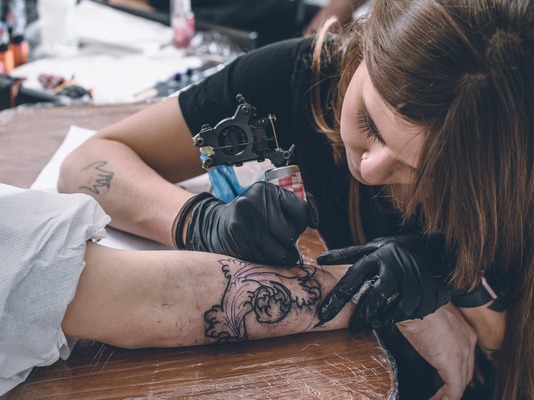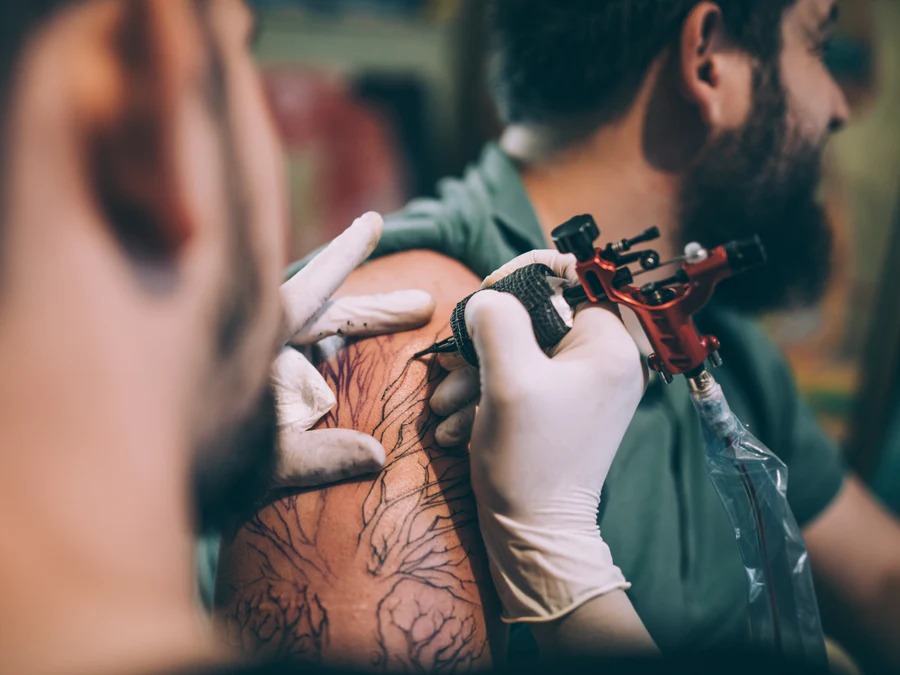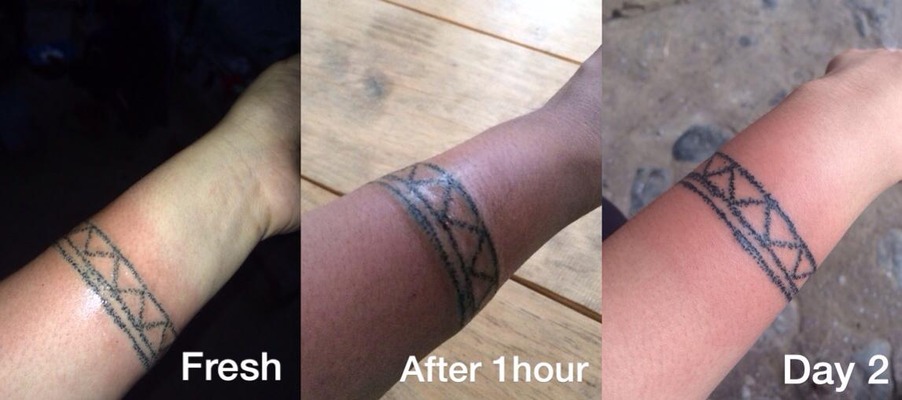After your tattoo session in the studio, your skin begins the healing process. It’s normal for the tattooed area to develop a scab on the top layer of skin, which can feel extremely itchy. To ensure a smooth healing, it’s crucial to prevent heavy or thick scabbing.
Here are some tips to help your newly inked skin recover effectively over the next few weeks without compromising the quality of the tattoo.
What is Tattoo Scabbing?-The Answer
[su_note note_color=”#D3D3D3″ radius=”6″]Tattoo scabbing is natural. However, if you see excessive scabs, pain, itchiness, redness, swelling, or discharge, seek medical attention to prevent infections or allergic reactions.[/su_note]

What is Tattoo Scabbing?
Tattoo scabbing is a natural part of the healing process. If you notice excessive scabbing, thick scabs, or symptoms like pain, itchiness, redness, swelling, or discharge, it’s important to seek medical attention from a qualified medical practitioner to address potential infections or allergic reactions.
How to Prevent Tattoo Scabbing
To minimize tattoo scabbing, maintain a clean and dry tattoo, avoid picking at the scabs, and apply an ointment or lotion as recommended by your tattoo artist. Ensure you avoid exposing the tattoo to excessive sunlight and moisture, which can slow down healing and increase infection risk.
Tattoo Aftercare Guide
To ensure proper tattoo healing, follow these concise aftercare tips: Gently wash the tattoo with warm water and antibacterial soap twice daily initially, then reduce to once daily. Pat dry with a clean paper towel—do not rub.
Apply a thin layer of tattoo balm or ointment to keep the area moisturized. Avoid tight clothing, direct sunlight, extreme temperatures, and water activities. Never pick at scabs to minimize the risk of infection.
How to treat tattoo scabbing
If your tattoo is scabbed, wash it gently with warm water and antibacterial soap. Apply a thin layer of balm or ointment to keep it moisturized and avoid picking at the scabs. Keep the tattoo out of direct sunlight and extreme temperatures.
If scabs are painful or show signs of infection like itching, redness, swelling, or discharge, see a medical practitioner. Let the scabs fall naturally to prevent damaging the underlying skin and ensure proper healing.
Scabs Are Normal
Scabs are a normal part of the healing process for a new tattoo. It’s important to remember not to pick or scratch at the scabs, as this can damage your ink. In the initial days, you may notice plasma, a yellowish liquid, seeping from the skin.
Keeping this fluid from remaining on the skin helps prevent heavy or thick scabbing. If you see green or yellow ooze, which indicates an infection, seek medical attention immediately. Proper aftercare procedures ensure your tattoo heals cleanly and remains healthy.
Avoiding Scabs
Flaking is a normal aspect of the healing process for a new tattoo. To prevent scabs that could prematurely drop off and cause color fading, it’s crucial to care properly for the tattoo. After you are inked, most tattoo shops will wrap your design in cling film or cloth to prevent injuries and keep out debris.
Remove the wrapping after 24 hours and gently wash the area, then lightly pat it dry with a towel. Avoiding strenuous activities like a workout shortly after getting a tattoo will help ensure the ink sets well without disruption.
Symptoms of a Skin Infection
Unfortunately, skin infections can occur after getting a new tattoo, especially if proper aftercare guidelines are not followed. Recognizing the symptoms early is crucial. If you see green or yellow pus, it is a clear sign of an infection.
Other indications include pain and red streaks emanating from the tattoo area. These symptoms are serious and require immediate attention. Make sure to see a doctor without delay if you experience any of these issues.
Timely medical treatment can prevent long-term problems and ensure your tattoo heals properly.
What to Expect During the Healing Process
After getting a tattoo, the healing process can take several days to weeks. In the first few days, the tattooed area may be swollen, red, and sore, which is normal and should subside. As the tattoo begins to heal, scabbing may occur as the body’s natural response to protect the wound and promote healing.
Scabbing is normal, but excessive scabbing can be a sign of a problem. It’s also normal for the tattoo to peel or flake as the body sheds the outer layer of skin, revealing the fresh, new tattoo underneath.
Scabbing Aftercare
Scabs require time to heal properly after getting a new tattoo, especially in delicate areas like an ankle tattoo. Typically, within a week or two, the scabs will dry out and fall off the skin.
It’s important to keep the skin moisturized, but remember to never apply lotion directly to the scabs. Instead, use a solution around the tattooed area to aid in hydration without interfering with the healing scabs.
Additionally, you should never pick or scratch at the scabs, as this can remove the ink and damage the appearance of your tattoo.
Removing Large Scabs
For large scabs on your new tattoo, particularly on sensitive areas like a hand tattoo, it’s important to never pick or rub the area. Instead, pat the tattoo dry with a clean towel and gently use antibacterial soap and water to soften the scabs.
Wrapping the tattoo initially helps prevent scabs from being prematurely ripped off. If scabs are stubborn, place a cloth over them during your shower for a few minutes to allow them to soak and lift away naturally as they dry.
Always consult your tattoo artist for aftercare if you’re unsure how to handle heavy scabs to ensure proper healing and avoid damage.
Understanding the Healing Process
Getting a tattoo can be an exciting and emotional experience, but it’s also a wound that needs proper care and attention during the healing period. One of the most common concerns after getting a tattoo is scabbing.
While normal scabbing is part of the healing process, excessive scabbing can indicate a problem such as an infection or an allergic reaction.
Causes of Tattoo Scabbing
Tattoo scabbing can be caused by a number of factors, including:
Excessive Ink
Sometimes, tattoo artists might overwork an area, causing excessive ink to be deposited into the skin. This can lead to scabbing as the body tries to expel the excess ink. Proper care is crucial during this healing period to manage any scabbing and promote healthy healing.
Tattoo Bubbling
Tattoo bubbling occurs when the needle penetrates too deeply, causing small, raised blisters and scabbing. This damage to the underlying layers of the skin needs proper care to heal effectively.
Don’t Pick Your Scabs
A key part of tattoo aftercare is to prevent picking or scratching the scab. Picking can remove ink, cause scarring, and lead to infection. Resist the urge to scratch and avoid tight or restrictive clothing over the tattooed area.
Avoid Water & Swimming
To prevent tattoo scabbing, it’s important to avoid exposing your tattoo to excessive moisture or water during the healing process. This means avoiding swimming, hot tubs, and saunas until your tattoo is fully healed.
Red, Infected Scabs
If you notice infection signs like excessive swelling, redness, or discharge, seek medical attention immediately. An infected tattoo might need antibiotics or surgical intervention. Tattoo scabbing is normal, but proper aftercare is essential.
Clean your tattoo regularly, use ointment or lotion as recommended, and avoid picking or scratching the scab.
Heal Tattoo Scabs Naturally (Don’t scratch)
To heal your tattoo properly, follow the aftercare instructions from your tattoo artist. Keep it clean and dry for the first few days, apply ointment or lotion, and avoid picking or scratching. Avoid exposing it to direct sunlight or soaking in water until it’s fully healed.
Excessively Scabbing Tattoos
It’s normal for a tattoo to scab, but keep an eye on the scabbing process to ensure it’s progressing well. If you notice excessive scabbing, thick scabs, or unusual colour, your tattoo may be infected. In this case, seek medical attention immediately to prevent further complications.
Your Scab Will Slowly Peel
When your tattoo begins peeling, it’s the top layer of skin peeling away to reveal the healed tattoo underneath. Avoid the urge to scratch or pick at the peels; doing so can disrupt the healing, leading to scarring or infection.
Ask Your Artist For Tattoo Tips
To prevent tattoo scabbing, always keep your tattoo clean and dry as it heals. This helps prevent infections and excessive scabbing. Also, avoid wearing tight clothing that rubs against the tattoo, as this can lead to more scabbing.
Tattoo Removal Scabbing
If you’re unhappy with your tattoo and considering removal, it’s important to understand that scabbing still occurs. However, the scabs during the removal process are typically lighter and less thick than in the healing process. Always talk to a professional to learn what to expect.
Scabbing Of Fresh Tattoos
After you’ve just gotten a tattoo, it’s important to be patient. Avoid the tempting urge to touch or scratch as this can cause scabs to form and disrupt the healing process. Be sure to follow the aftercare instructions provided by your tattoo artist to ensure the tattoo heals properly.
When Will My Scab Fall Off?
As your tattoo heals, the scabs will eventually fall off. This is normal and indicates that your tattoo is healing properly. It’s important not to pick or scratch the scabs, as this can lead to scarring or infection.
Frequently Asked Question
Should I still moisturize a scabbing tattoo?
Gently pat the area dry to avoid pulling on the sticky scab. A moist scab can latch onto your towel, making the process painful. Hydrating your tattooed skin is essential for a healthy recovery. A dry tattoo scab is more likely to crack, leading to painful bleeds and infections.



